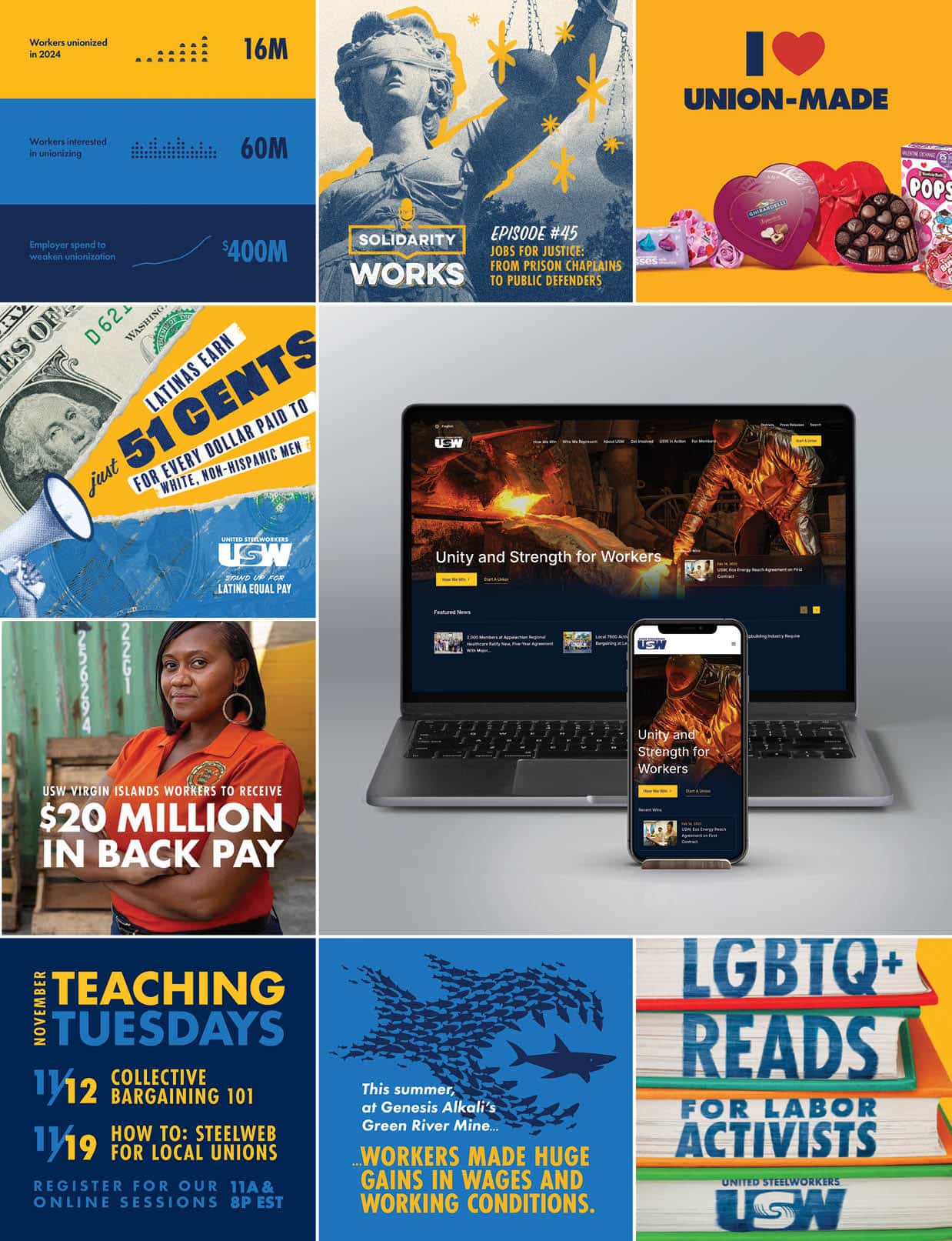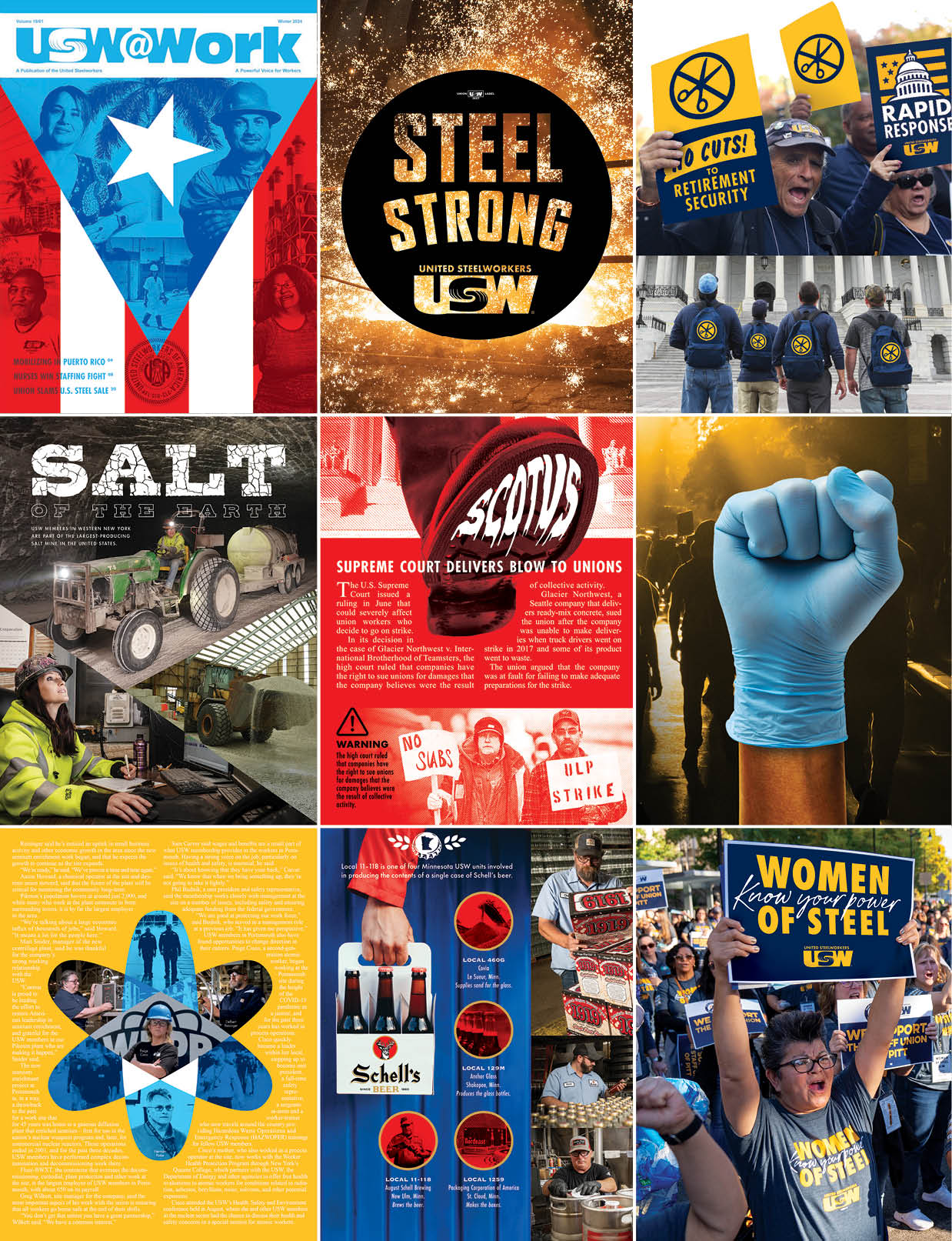The Communications Department underwent significant changes since the 2022 convention. Early last year, we were proud to welcome our siblings from the New Media Department into a new, unified communications team that is more efficient and streamlined.
This means that the Communications Department now oversees both print and digital media. This includes the weekly blog; the monthly podcast Solidarity Works; the quarterly magazine, USW@Work; and a number of sector newsletters, as well as the social media channels, the website, print and digital graphics, photography and video.
We also continue to coordinate press relations, generate op-eds and earned media, handle our union’s advertising needs and supply visual materials for USW conferences.
The tools and resources the Communications Department offers help to advance a wide range of the union’s top priorities, from organizing and bargaining to legislative and political work. We also provide support for districts and locals to help amplify our members’ stories across a wide variety of platforms.
We are optimistic that the new departmental alignment will afford us exciting opportunities to further build momentum, keep our messages clear and consistent across platforms, and afford more members opportunities to share stories of our union’s success.
Debuting a New Website
Earlier this year, we launched a brand-new version of our website: usw.org. Despite changes to the layout, the site will continue to be a hub for important information and updates about the union. Staff and members alike continue to rely on it for information about upcoming events, to check out the latest union news and to find a wide variety of USW stories.
It obviously looks sleeker and more modern, but there are a number of practical improvements as well, including greater functionality on mobile devices. Though it may take users some time to get used to the new format, the upgrade significantly increases accessibility, making the website a better tool for use across our union.
We are also rolling out an updated version of Union Hall. This similarly should give locals the opportunity for a more modern-looking, better functioning website. As local union communicators transition to the new format, we are, as ever, available to provide training and support.

Highlighting Bargaining Wins
Winning at the bargaining table provides life-changing improvements for USW members, but promoting the wins also affords us the opportunity to help other workers understand what is possible, both so that our union siblings can work toward comparable contracts at their facilities and so that unorganized workers understand the benefits of union representation.
To achieve these goals, it’s often necessary to break down the win into individual components and highlight specific victories that may be relevant to other workers.
For example, our union had a great deal of success over the past three years in beating back and dismantling two-tiered systems intended to divide and weaken us. Through the blog, the podcast, the magazine and more, we shined a special spotlight on this sort of victory, highlighting individual members’ stories and illustrating the power of our solidarity.
We were pleased to help advance a number of specific bargaining campaigns over the past three years, including some hard-won battles that took months or even years to resolve.
During the basic steel negotiations in 2022, the Communications Department worked with Strategic Campaigns and others to build solidarity and keep members informed about progress at the table, including through membership updates, signs, stickers and a newly designed T-shirt.
We also supported the five-month nurses’ strike at Robert Wood Johnson University Hospital in 2023, for which we produced signs, videos, media relations, photography, a website and more.
Messaging was particularly important during this campaign, both because we needed to rally the community around the issue of safe staffing and because our members faced an employer with a powerful PR apparatus at its disposal. Ultimately, it was individual members telling their own stories that defined the strike and what was at stake for nurses and patients alike.
Protracted efforts like those of the workers at the Carnegie Museums of Pittsburgh also garnered significant, sustained press attention, which we were happy to coordinate. We were also pleased to celebrate their victories on social media and across our other channels.
Publicizing these sorts of wins was not only important for building solidarity in these new units but also in building momentum for additional wins, particularly as more professional and technical workers were able to learn about our union and envision their place within it.
Organizing in the South
Our union is constantly evolving and growing, and nowhere has that been more readily apparent than in the South, where we proudly welcomed more than 1,500 new members from the bus maker Blue Bird.
Messaging on this campaign was key for a number of reasons. Namely, we were up against the mistaken perception that the South remained inhospitable to unions, that a long history of anti-union lawmakers and greedy employers could somehow stand in the way of workers exercising their rights.
These new members, however, showed that regardless of where they live, workers can improve their wages and working conditions by banding together. Through both local and national media, we were able to shine a light on the working conditions at Blue Bird and help ensure workers had access to a free and fair election.
Publicizing the win was doubly important because Blue Bird workers manufacture electric school buses, and their facility received significant financial support through programs like the Inflation Reduction Act. It was our job to reinforce to the company and lawmakers that taxpayer dollars should never go toward union busting and that any corporation accepting these sorts of funds must respect workers’ rights.
On video, in print, through the media and at in-person events, Blue Bird workers had a number of exciting opportunities to share their stories. And we’ve been proud to help as they show that the jobs of the future are union jobs—regardless of where in North America someone might live.
Supporting Unionizing Drives at the University of Pittsburgh
The Communications Department was pleased to support all three of the union’s efforts at the University of Pittsburgh.
This included the Pitt faculty, who spent the better part of three years fighting for their first contract. Given the protracted timeline, it was important to keep up a steady stream of messaging, both across the unit and in the media.
We had great success in building relationships with the two university-based publications and other local media to help keep stakeholders apprised of the progress at the table— and ultimately the win.
Our union also welcomed more than 6,000 new members last year as the Pitt staff voted to join the USW. We relied heavily on both in-person and electronic communications to share worker stories and help build solidarity across multiple locations and occupations.
To help spread our message and generate enthusiasm for the campaign, our department provided a number of high-energy posters and billboards for use around campus. From taking the pictures to creating the graphics, we were able to produce lively, highly visible opportunities for staff to learn more about the campaign and the benefits of our union.
We also designed a campaign-specific website as staff made their transition from organizing into contract negotiations, so that our new siblings could stay connected and on the same page as they developed their own internal communications networks as a part of the USW.
Finally, we assisted the Pitt graduate workers in their efforts to organize into our union. While we certainly relied on a number of tried and true tactics, we also were able to assist in some lighter, social media-oriented messaging, including an organizing-themed dance video set to Chappell Roan’s song “Hot to Go.”
Bringing Back Shipbuilding
A single commercial ship can require approximately 13,000 tons of structural steel, 60,000 gallons of paint, 130 miles of electrical cable and countless other products that thousands of USW members in industries up and down the shipbuilding supply chain produce.
The domestic shipbuilding industry, however, continues to diminish as the People’s Republic of China (PRC) pursues its comprehensive strategy to dominate global transportation and logistics networks, costing tens of thousands of good, union jobs.
Last year, the USW led a coalition of unions in filing a Section 301 trade petition against Chinese shipbuilding to push back against these predatory practices and revitalize this essential domestic industry.
The campaign, “Full Steam Ahead,” required building awareness of the precarious nature of domestic shipbuilding on a number of levels, both internally and externally. This included a number of media events with congressional allies, op-eds, one-on-one interviews, and other outreach, all of which the Communications Department coordinated.
We also provided a website, ads, social media graphics and other visual materials as we promoted the effort in Washington, D.C., and beyond.
The USW has long been a leader in pursuing fair trade, and this campaign offered an opportunity for a wide array of our sectors to come together to demonstrate both the national security implications and job creating potential of worker-centered policies.
Celebrating Other Legislative and Policy Victories
There were a number of other legislative and policy victories that the Communications Department helped promote through the blog, podcast, magazine and social media channels.
This included news out of the Occupational Safety and Health Administration, like the walkaround rule, specifying that workers can have the representative of their choosing during an OSHA investigation, and the proposed heat standard, which would institute common-sense guidelines to help keep workers safe in extreme heat.
These sorts of wins don’t always make headlines, but they’re obviously deeply significant for USW members, which is why we dedicate our resources to spreading the word when our policymakers deliver for workers.
As investments through the Inflation Reduction and CHIPS and Science Acts continue to roll out, we are also happy to help showcase the ways in which these investments are not only helping to make our supply chains more resilient and our communities more secure, but are also fostering the growth of good, union jobs.
These investments directly benefit USW members, like those of Local 17M at Gallo Glass in Modesto, Calif. Last year, the Department of Energy awarded Gallo up to $75 million to build a new, hybrid electric gas furnace to be fueled by locally produced renewable energy.
The furnace will cut emissions, reduce costs and increase the use of recycled material in the manufacturing process. And it will help to keep the facility—where workers make bottles for wine, olive oil, sparkling waters and other products—viable and competitive for generations.
As we continue to push for transformative investments in our plants and industries, these sorts of stories of real people gaining real benefits are essential for keeping the momentum going.
Finally, as our union continues to push Congress to reauthorize Trade Adjustment Assistance and other needed legislation, the Communications Department documented member fly-ins in both video and photography, providing a compelling visual component and helping extend the reach of the meetings beyond the individual offices.
For example, George Walsh, a member of Local 10-00086, lobbied for federal legislation that expands funding for veteran outreach and services. Through a moving video, we told the story of what motivates him: his father-in-law, a Vietnam veteran and former U.S. Marine, Jackie Garland, who would have greatly benefited from the resources for which our union successfully advocated.
USW activists like Walsh and so many others are driving positive change in our communities and our halls of government, and, as ever, the Communications Department is proud to make sure they get as wide a platform as possible to share their perspectives.
